Thanks to an information request to the SSP‑CDMX hoyodecrimen.com now has crime data at the
latitude and longitude level. You
can access the data systematically using the
API or
download it in full. In this post
I’ll provide many examples of how to manipulate the API to create maps.
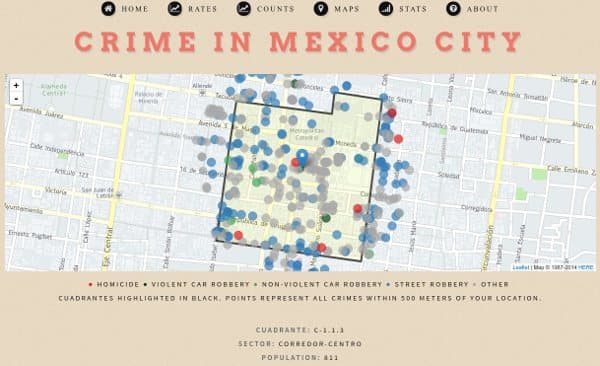
I.
First, we’ll load the R packages we need:
1
2
3
4
5
6
7
8
9
10
11
12
13
14
15
16
17
18
19
20
21
22 | library("DCluster")
library("jsonlite")
library("RCurl")
library("jsonlite")
library("rgdal")
library("rgeos")
library("ggplot2")
library("ggmap")
library("RColorBrewer")
library("stringr")
library("scales")
library("geojsonio")
library("downloader")
library("spdep")
library("viridis")
library("maptools")
library("rvest")
library("dplyr")
library("stringr")
library("stringi")
library("geojsonio")
library("knitr")
|
Then, we’ll download a list of all crimes available from hoyodecrimen
(since the data comes from
FOIA request the specific crimes
available may vary depending on when you access the API). To do this,
we can use the jsonlite package to convert the JSON data the API
endpoints return into data.frames.
| crimes <- fromJSON("https://hoyodecrimen.com/api/v1/crimes")$rows
kable(crimes, caption = 'List of crimes available from hoyodecrimen.com')
|
| crime |
| HOMICIDIO DOLOSO |
| LESIONES POR ARMA DE FUEGO |
| ROBO A BORDO DE METRO C.V. |
| ROBO A BORDO DE METRO S.V. |
| ROBO A BORDO DE MICROBUS C.V. |
| ROBO A BORDO DE MICROBUS S.V. |
| ROBO A BORDO DE TAXI C.V. |
| ROBO A CASA HABITACION C.V. |
| ROBO A CUENTAHABIENTE C.V. |
| ROBO A NEGOCIO C.V. |
| ROBO A REPARTIDOR C.V. |
| ROBO A REPARTIDOR S.V. |
| ROBO A TRANSEUNTE C.V. |
| ROBO A TRANSEUNTE S.V. |
| ROBO A TRANSPORTISTA C.V. |
| ROBO A TRANSPORTISTA S.V. |
| ROBO DE VEHICULO AUTOMOTOR C.V. |
| ROBO DE VEHICULO AUTOMOTOR S.V. |
| VIOLACION |
All requests to the API start with the address
https://hoyodecrimen.com/api/v1/ followed by the specific path of
the data you want, sometimes with query parameters (the part of the url
followed by ?) specifying the start and end dates of the data you need.
If you wanted to download the sum of all murders commited in CDMX
since 2014 you’d look up the appropriate method in the
documentation. And
then use the following code to create a chart:
| # Note that since the crime we want to graph, 'Homicidio Doloso',
# contains a space we need to encode the URL
homicidio_series <- fromJSON(str_c("https://hoyodecrimen.com",
URLencode("/api/v1/df/crimes/HOMICIDIO DOLOSO/series?start_date=2014-01&end_date=2016-09")))$rows
kable(head(homicidio_series), caption = 'Homicides in CDMX since 2014')
|
| count |
crime |
date |
population |
| 71 |
HOMICIDIO DOLOSO |
2014-01 |
8785911 |
| 55 |
HOMICIDIO DOLOSO |
2014-02 |
8785911 |
| 91 |
HOMICIDIO DOLOSO |
2014-03 |
8785911 |
| 76 |
HOMICIDIO DOLOSO |
2014-04 |
8785911 |
| 64 |
HOMICIDIO DOLOSO |
2014-05 |
8785911 |
| 78 |
HOMICIDIO DOLOSO |
2014-06 |
8785911 |
| ggplot(homicidio_series, aes(as.Date(str_c(date, "-01")), count)) +
geom_line() +
ggtitle("CDMX - HOMICIDIO DOLOSO") +
xlab("date") +
scale_y_continuous(expand = c(0, 0), limits = c(0, max(homicidio_series$count)))
|

We can also download geojson maps of
cuadrantes
and
sectores
which we can convert to SpatialPolygonsDataFrame to work with in R.
1
2
3
4
5
6
7
8
9
10
11
12 | # create a tempory to save the geojson from the API
tmp_cuadrantes = tempfile("cuads", fileext = ".json")
download("https://hoyodecrimen.com/api/v1/cuadrantes/geojson", tmp_cuadrantes)
# read the geojson into a spatial object
cuadrantes = readOGR(tmp_cuadrantes, "OGRGeoJSON", verbose = FALSE)
tmp_sectores = tempfile("secs", fileext = ".json")
download("https://hoyodecrimen.com/api/v1/sectores/geojson", tmp_sectores)
sectores = readOGR(tmp_sectores, "OGRGeoJSON", verbose = FALSE)
plot(cuadrantes, main = "cuadrantes")
plot(sectores, main = "sectores")
|

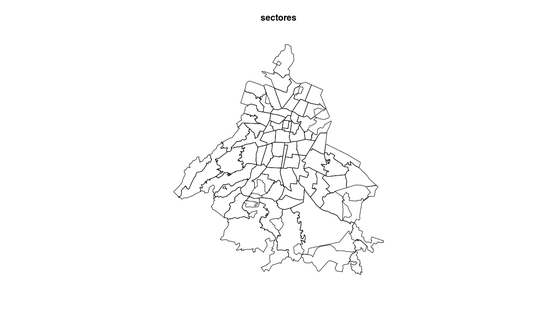
II.
Now that we have the maps, we can download
period data
(by default the last twelve months) for all crimes and merge
them. Then use the ggmap package to create choropleths on top of a
Google Maps image.
1
2
3
4
5
6
7
8
9
10
11
12
13
14
15
16
17
18
19
20
21
22
23
24
25
26
27
28
29 | crime.sectors <- fromJSON("https://hoyodecrimen.com/api/v1/sectores/all/crimes/all/period")$rows
#fortify the data for ggplot2
fsectors <- fortify(sectores, region = "sector")
sector.map <- left_join(fsectors, crime.sectors, by = c("id" = "sector"))
sector.map$rate <- sector.map$count / sector.map$population * 10^5
crime.cuadrantes <- fromJSON("https://hoyodecrimen.com/api/v1/cuadrantes/all/crimes/all/period")$rows
fcuadrantes <- fortify(cuadrantes, region = "cuadrante")
cuadrante.map <- left_join(fcuadrantes, crime.cuadrantes, by = c("id" = "cuadrante"))
cuadrante.map$rate <- cuadrante.map$count / cuadrante.map$population * 10^5
draw_gmap <- function(map, crimeName, bb, pal, fill = "rate", alpha=.9) {
ggmap(get_map(location = bb)) +
geom_polygon(data= subset(map, crime == crimeName),
aes_string("long", "lat", group = "group", fill = fill),
color = "#666666", size = .1,
alpha = alpha) +
coord_map() +
ggtitle(crimeName) +
#scale_fill_viridis(option="plasma") +
scale_fill_continuous(low = brewer.pal(9, pal)[1],
high = brewer.pal(9, pal)[9],
space = "Lab", na.value = "grey50",
guide = "colourbar") +
theme_nothing(legend = TRUE)
}
bb.sector <- bbox(sectores)
draw_gmap(sector.map, "HOMICIDIO DOLOSO", bb.sector, "Reds", "rate")
|

| draw_gmap(sector.map, "LESIONES POR ARMA DE FUEGO", bb.sector, "Greys", "rate")
|

| draw_gmap(sector.map, "ROBO A TRANSEUNTE C.V.", bb.sector, "Greys", "rate")
|
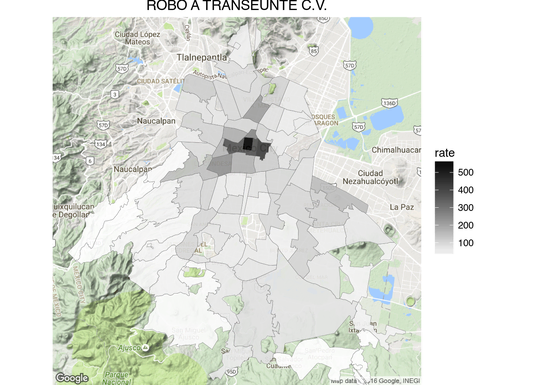
| draw_gmap(cuadrante.map, "ROBO DE VEHICULO AUTOMOTOR S.V.", bb.sector, "YlGn", "count")
|

| draw_gmap(cuadrante.map, "ROBO DE VEHICULO AUTOMOTOR C.V.", bb.sector, "Greens", "count")
|
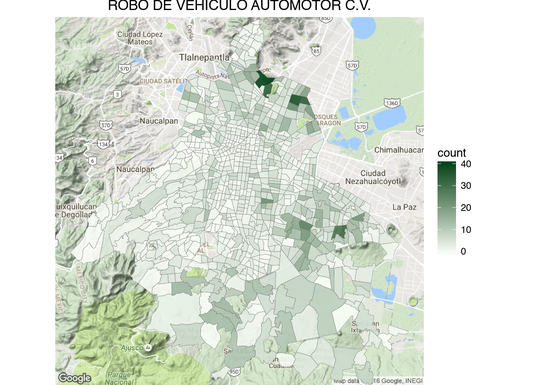
| draw_gmap(cuadrante.map, "LESIONES POR ARMA DE FUEGO", bb.sector, "Greys", "count")
|
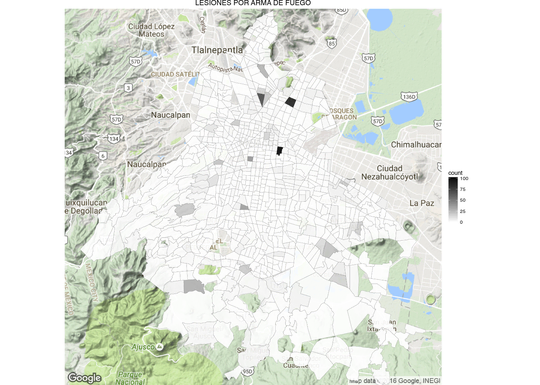
| draw_gmap(cuadrante.map, "HOMICIDIO DOLOSO", bb.sector, "Reds", "count")
|
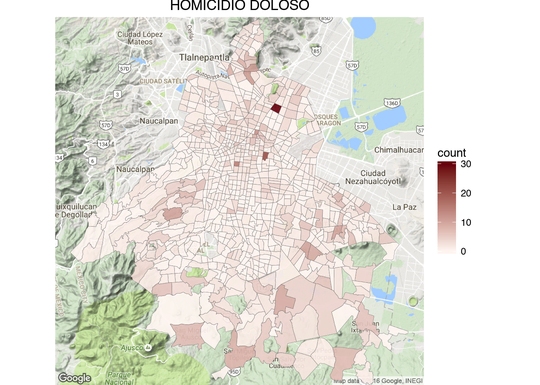
III.
One thing that you may have noticed from the ‘Homicidio Doloso’ and
‘Lesiones por Arma de Fuego’ cuadrante maps is that the cuadrantes
that contain hospitals tend to have very high homicides counts (dark
red and gray in the maps).
We can investigate the phenomena further by
downloading the coordinates
of homicides and firearm lesions within 1,000 meters of hospitals.
1
2
3
4
5
6
7
8
9
10
11
12
13
14
15
16
17
18
19
20
21
22
23
24
25
26
27
28
29
30
31
32
33
34
35
36
37
38
39 | #function to download a cuadrante given a latitude and longitude
get_cuadrante <- function(long, lat){
tmp_file = tempfile(fileext = ".geojson")
write(fromJSON(str_c("https://hoyodecrimen.com/api/v1/cuadrantes/pip/",long,"/",lat))$pip$geometry,
file = tmp_file)
cuad <- geojson_read(tmp_file, method = "local", what = "sp")
cuad.f <- fortify(cuad)
}
#function to create a point map of crimes with their cuadrante
latlong_map <- function(title, lat, long, distance, crime = "HOMICIDIO DOLOSO",
fill = "red") {
geocrimes <- fromJSON(str_c("https://hoyodecrimen.com/api/v1/latlong/crimes/",
URLencode(crime), "/coords/",
long,
"/",
lat,
"/distance/",
distance,
"?start_date=2013-01&end_date=2016-09"))$rows
cuadrante.f <- get_cuadrante(long, lat)
bb <- bbox(coordinates(geocrimes[,c("long", "lat")]))
ggmap(get_map(location = bb)) +
geom_polygon(data = cuadrante.f, aes(long, lat, group = group),
color = "black", fill = "yellow", alpha = .2) +
geom_point(data= subset(geocrimes, crime == crime),
aes(long, lat),
fill = fill,
color = "black",
size = 3,
shape = 21,
alpha = .8) +
ggtitle(title) +
theme_nothing(legend = TRUE)
}
latlong_map("Hospital Balbuena - Murder", 19.42410, -99.115520, 1000)
|

Interactive Map
| latlong_map("Hospitales en Lindavista - Murder", 19.482973, -99.134091, 1000)
|
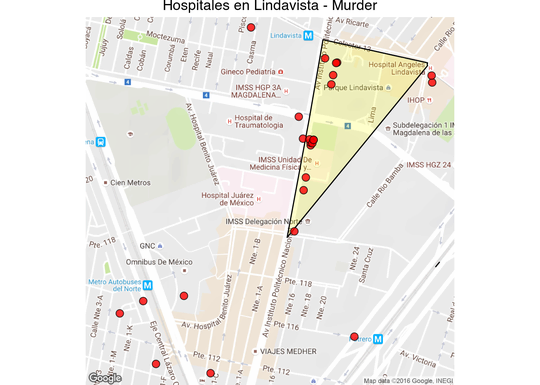
Interactive Map
| latlong_map("Hospital General - Murder", 19.411300, -99.152405, 1000)
|
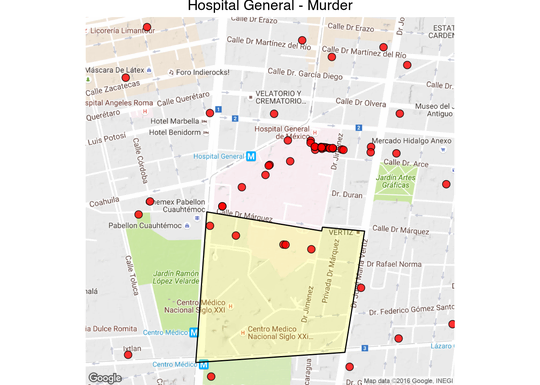
Interactive Map - Note that there is a second hospital in another cuadrante.
| latlong_map("Hospital General Iztapalapa - Murder", 19.343515, -99.027382, 1000)
|

Interactive Map
| latlong_map("Hospital General Iztapalapa - Firearm Lesions",
19.343515, -99.027382,
1000,
"LESIONES POR ARMA DE FUEGO", fill = "darkgray")
|
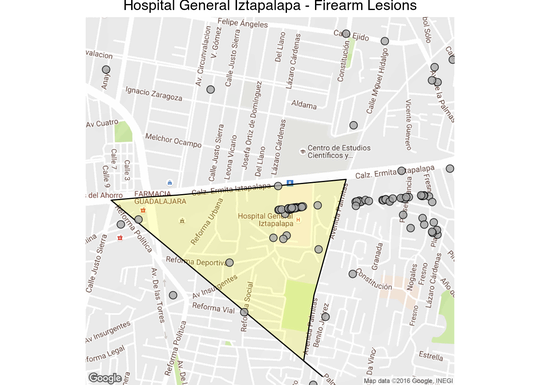
While narcos sometimes
kill the wounded receiving care in hospitals,
this is the exception rather than the rule. It looks like some
homicides are recorded with the latitude and longitude of the place of
death, and in the case of firearm lesions I’m guessing it’s where the
crime was reported to the police. Also note that there is a certain
amount of error associated with the location of each crime, while the
cuadrante where the crime was recorded is usually correct, the latitude
and longitude sometimes is off by a 100 meters or so.
These are the cuadrantes codes with hospitals and an unusual number of victims:
- O-2.5.7
- O-2.2.4
- N-4.4.4
- N-1.3.10
- C-2.1.16
- N-2.2.1
- P-1.5.7
- P-3.1.1
Just for fun here are the cuadrantes with the highest counts of car robbery:
| latlong_map("Mercado Xochimilo - Car Robbery wo/violence", 19.251478, -99.094207, 1000, "ROBO DE VEHICULO AUTOMOTOR S.V.", fill = "green")
|
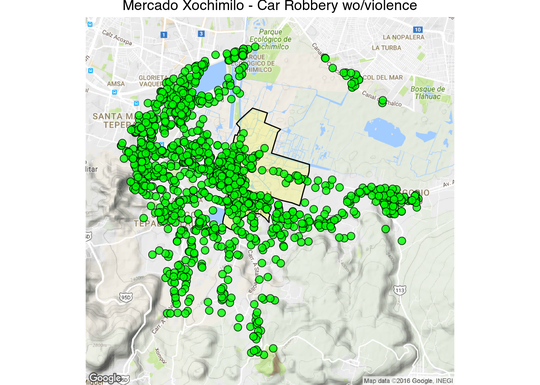
| latlong_map("Lindavista - Car Robbery w/violence", 19.506460, -99.122815, 1000, "ROBO DE VEHICULO AUTOMOTOR C.V.", fill = "darkgreen")
|
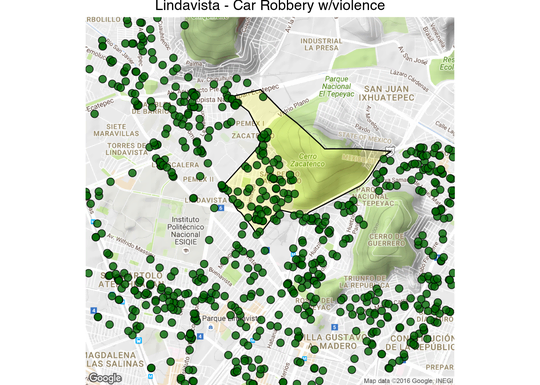
IV.
Ideally we’d like to be able to map the rates of crimes at the
cuadrante delictivo level, like we did with the sectores, but the
crime rates can be statistically unstable due to the small size of the
cuadrantes and the relative small number of people at risk. Plus, as I
mentioned, homicides and firearm lesions are sometimes recorded as
having happened inside a hospital. To get a better sense of the crime
risk in each cuadrante we are going to smooth the rate using empirical
bayes smoothing:
1
2
3
4
5
6
7
8
9
10
11
12
13
14
15
16
17
18
19
20
21
22
23
24
25
26
27
28 | # Construct neighbours list from polygon list
cuad.nb <- poly2nb(cuadrantes, row.names = as.character(cuadrantes$cuadrante))
hom <- fromJSON(str_c("https://hoyodecrimen.com",
URLencode("/api/v1/cuadrantes/ALL/crimes/HOMICIDIO DOLOSO/period")))$rows
hom <- subset(hom, cuadrante != "(NO ESPECIFICADO)")
# match the order with the neighborhood file
hom <- hom[match(cuadrantes$cuadrante, hom$cuadrante),]
# fill in the population of cuadrantes with zero residents
# with the mean of their neighboring cuadrantes
for(zero_cuad in hom$cuadrante[which(hom$population == 0)])
hom$population <- mean(hom$population[cuad.nb[[which(hom$cuadrante == zero_cuad)]]])
hom$rate <- hom$count / hom$population * 10^5
smth<-empbaysmooth(hom$count, hom$population * sum(hom$count) / sum(hom$population))
hom$smooth <- smth$smthrr
cuadrantes.f <- fortify(cuadrantes, region = "cuadrante")
cuadrantes.f <- merge(cuadrantes.f, hom, by.x = "id", by.y = "cuadrante")
ggplot(cuadrantes.f, aes(long, lat, group = group)) +
geom_polygon(aes(fill = smooth), color = "#555555", size = .1) +
coord_map()+
scale_fill_gradientn(colours=rev(brewer.pal(9,"YlOrRd"))) +
theme_nothing(legend = TRUE) +
ggtitle("Smoothed homicide rates at the cuadrante level")
|
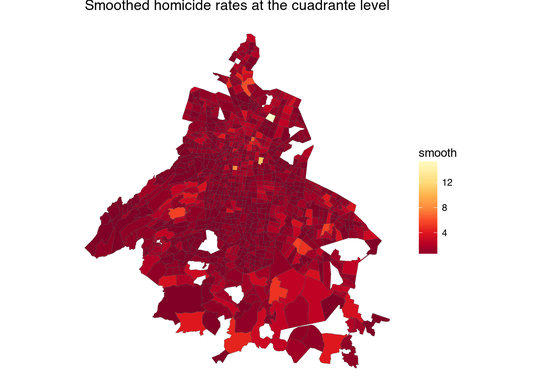
The cuadrantes with hospitals still give the impression of being
extremely violent. One interesting thing about hospital with lots of
murders is that the cuadrantes surrounding them also tend to have a lot
of murders —there is a lot of violence near some hospitals.
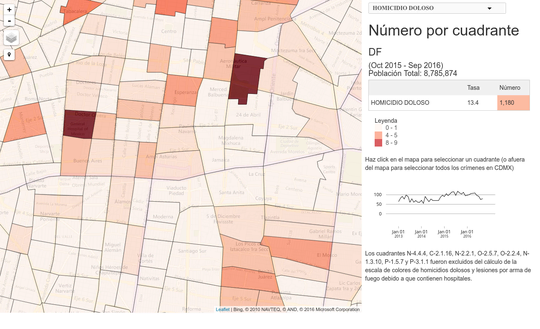
This makes it more likely that the people who died in a hospital were
injured in a nearby location and were then transported to the nearest
hospital. A solution to the problem of cuadrantes with
hospitals being incorrectly perceived as very violent would be to
average the rate of violence in each cuadrante with the nearest, say,
8 neighbors.
1
2
3
4
5
6
7
8
9
10
11
12
13
14
15
16
17
18
19
20 | cuad.nb <- knn2nb(knearneigh(coordinates(cuadrantes), k = 8),
row.names = as.character(cuadrantes$cuadrante))
#cuad.nb <- poly2nb(cuadrantes, row.names = as.character(cuadrantes$cuadrante))
plot(cuad.nb, coordinates(cuadrantes))
hom$smooth <- sapply(1:nrow(hom), function(x) {
w <- c(hom$population[x], hom$population[cuad.nb[[x]]])
r <- c(hom$rate[x], hom$rate[cuad.nb[[x]]])
return(sum(w * r)/sum(w))
})
cuadrantes.f <- fortify(cuadrantes, region = "cuadrante")
cuadrantes.f <- merge(cuadrantes.f, hom, by.x = "id", by.y = "cuadrante")
ggplot(cuadrantes.f, aes(long, lat, group = group)) +
geom_polygon(aes(fill = smooth), color = "#555555", size = .1) +
coord_map()+
scale_fill_gradientn(colours=rev(brewer.pal(9,"YlOrRd"))) +
theme_nothing(legend = TRUE) +
ggtitle("Smoothed homicide rates by nearest neighbors")
|
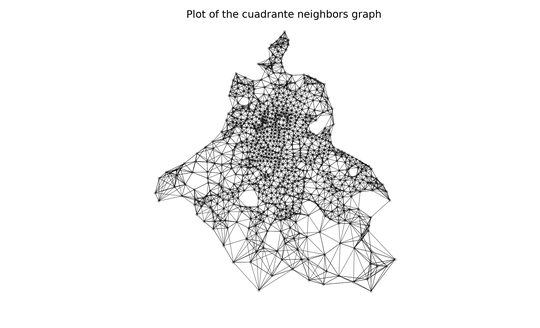

Now it looks much better, and this is what the frontpage of
hoyodecrimen uses to compare crime rates
in your cuadrante (though we’re still missing uncertainty
estimates). We can use the same averaging method for other crimes:
1
2
3
4
5
6
7
8
9
10
11
12
13
14
15
16
17
18
19
20
21
22
23
24
25
26
27
28
29
30
31
32
33
34 | smooth_cuads <- function(df, cuad.nb) {
df <- subset(df, cuadrante != "(NO ESPECIFICADO)")
# match the order with the neighborhood file
df <- df[match(cuadrantes$cuadrante, df$cuadrante),]
# fill in the population of cuadrantes with zero residents
# with the mean of their neighboring cuadrantes
for(zero_cuad in df$cuadrante[which(df$population == 0)])
df$population <- mean(df$population[cuad.nb[[which(df$cuadrante == zero_cuad)]]])
df$rate <- df$count / df$population * 10^5
df$smooth <- sapply(1:nrow(df), function(x) {
w <- c(df$population[x], df$population[cuad.nb[[x]]])
r <- c(df$rate[x], df$rate[cuad.nb[[x]]])
return(sum(w * r)/sum(w))
})
cuadrantes.f <- fortify(cuadrantes, region = "cuadrante")
cuadrantes.f <- merge(cuadrantes.f, df, by.x = "id", by.y = "cuadrante")
cuadrantes.f
}
#cuad.nb <- poly2nb(cuadrantes, row.names = as.character(cuadrantes$cuadrante))
cuad_smooth_rvsv <- smooth_cuads(fromJSON("https://hoyodecrimen.com/api/v1/cuadrantes/ALL/crimes/ROBO DE VEHICULO AUTOMOTOR S.V./period")$rows,
cuad.nb)
ggplot(cuad_smooth_rvsv, aes(long, lat, group = group)) +
geom_polygon(aes(fill = smooth), color = "#555555", size = .1) +
coord_map()+
scale_fill_gradientn(colours=rev(brewer.pal(9,"YlGn"))) +
theme_nothing(legend = TRUE) +
ggtitle("Smoothed car robbery wo/v rates by nearest neighbors")
|
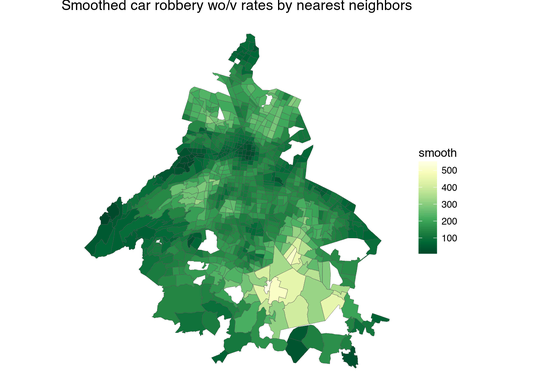
| cuad_smooth_rvcv <- smooth_cuads(fromJSON("https://hoyodecrimen.com/api/v1/cuadrantes/ALL/crimes/ROBO DE VEHICULO AUTOMOTOR C.V./period")$rows,
cuad.nb)
ggplot(cuad_smooth_rvcv, aes(long, lat, group = group)) +
geom_polygon(aes(fill = smooth), color = "#555555", size = .1) +
coord_map() +
scale_fill_gradientn(colours=rev(brewer.pal(9,"BuGn"))) +
theme_nothing(legend = TRUE) +
ggtitle("Smoothed car robbery w/v rates by nearest neighbors")
|

| cuad_smooth_rt <- smooth_cuads(fromJSON("https://hoyodecrimen.com/api/v1/cuadrantes/ALL/crimes/ROBO A TRANSEUNTE C.V./period")$rows,
cuad.nb)
ggplot(cuad_smooth_rt, aes(long, lat, group = group)) +
geom_polygon(aes(fill = smooth), color = "#555555", size = .1) +
coord_map() +
scale_fill_gradientn(colours=rev(brewer.pal(9,"Blues")))+
theme_nothing(legend = TRUE) +
ggtitle("Smoothed street robbery rates by nearest neighbors")
|
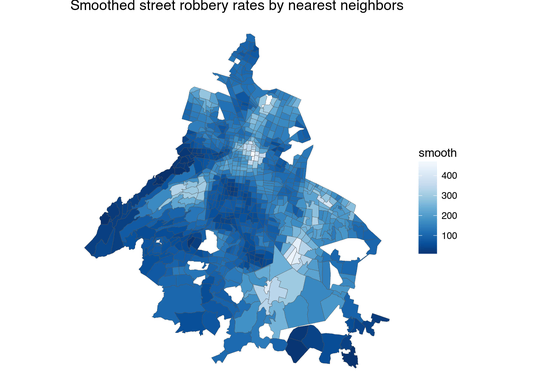
There’s still a problem in that to calculate the rates we are using as
denominator the number of people living in the cuadrante, and people
move around the city all time.
V.
The Mexico City subway website publishes the number of
passangers using each metro station which we can use to estimate crime
rates by station. First, we download crime data from January to March
2016 since that matches the ridership data available from the
Sistema Colectivo website.
And we’ll only estimate rates for the sum of the following crimes:
- ROBO A TRANSEUNTE C.V.
- ROBO A TRANSEUNTE S.V.
- ROBO A BORDO DE TAXI C.V
- ROBO A BORDO DE MICROBUS S.V.
- ROBO A BORDO DE MICROBUS C.V.
- ROBO A BORDO DE METRO S.V.
- ROBO A BORDO DE METRO C.V.
| # Set the distance to ridiculously large number of meters to download all CDMX data
geocrimes <- fromJSON(str_c("https://hoyodecrimen.com/api/v1/latlong/crimes/",
URLencode("ROBO A TRANSEUNTE C.V.,ROBO A TRANSEUNTE S.V.,ROBO A BORDO DE TAXI C.V.,ROBO A BORDO DE MICROBUS S.V.,ROBO A BORDO DE MICROBUS C.V.,ROBO A BORDO DE METRO S.V.,ROBO A BORDO DE METRO C.V."),"/coords/-99.122815/19.506460/distance/50000000000?start_date=2016-01&end_date=2016-04"))$rows
|
Then we clean the ridership data from the
metro website. I
had to clean up the html by hand a bit since it’s so badly formed the
rvest package
was unable to parse it.
1
2
3
4
5
6
7
8
9
10
11
12
13
14
15
16
17
18
19
20
21
22
23
24
25
26
27
28
29
30
31
32
33
34
35
36
37 | con <- file("data/afluencia.html", "rb")
metro <- read_html(con)
afluencia <- data.frame()
for(i in 1:4) {
df <- metro %>%
html_nodes("table") %>%
.[[i]] %>%
html_table(fill = TRUE)
afluencia <- rbind(afluencia,
data.frame(name=df[2:(nrow(df)-1),1],
num=df[2:(nrow(df)-1),2],
line=df[1,1]),
data.frame(name=df[2:(nrow(df)-1),4],
num=df[2:(nrow(df)-1),5],
line=df[1,4]),
data.frame(name=df[2:(nrow(df)-1),7],
num=df[2:(nrow(df)-1),8],
line=df[1,7]))
}
nbs <- stri_escape_unicode(afluencia$name[21])
# \\u00a0 is actually the non-breaking space character
# which we have to remove from the html table
afluencia <- afluencia %>%
mutate(num = as.numeric(str_replace_all(num, ",", ""))) %>%
mutate(name = str_replace_all(name, "[\r\n]" , " ")) %>%
mutate(name = str_replace_all(name, " " , " ")) %>%
mutate(name = str_replace(name, "\\u00a0", "")) %>%
mutate(name = str_replace(name, " ", " ")) %>%
mutate(name = tolower(name)) %>%
filter(name != "") %>%
mutate(line = str_replace_all(line, "[\r\n]" , " ")) %>%
mutate(line = str_replace_all(line, " " , " ")) %>%
mutate(line = str_replace_all(line, " " , " "))
|
Then we merge the ridership numbers with a list of geocoded stations previously
download from here and converted to
a csv with the latitude and longitude of each metro station.
| stations <- read.csv("data/stations.csv") %>%
mutate(name = tolower(name)) %>%
rename(line = styleUrl) %>%
mutate(line = str_replace(line, "#Line", "LÍNEA "))
df <- full_join(stations, afluencia, by = c("name", "line"))
nrow(df[is.na(df$X) | is.na(df$num),]) == 0
|
To compute the rates by station we are going to draw a 200m buffer
around each station point. Sometimes stations are very close to each
other and we have to be sure to merge them and sum their ridership
numbers if their buffers intersect. This can be done by using Postgresql with the
following SQL code:
1
2
3
4
5
6
7
8
9
10
11
12 | SELECT json_build_object(
'type', 'Feature',
'id', name,
'geometry', ST_Union(the_geom::geometry),
'properties', json_build_object(
'name', name,
'num', sum(num)
)
)
FROM (SELECT ST_Buffer(the_geom_webmercator::geometry,200) as the_geom,name, line, num
FROM geocoded_stations) as buffers
GROUP BY name
|
I’ve also uploaded the station points to carto so you
don’t have to install Postgresql and can download the geojson file of the station
buffers by running the SQL in the cloud.
| url <- str_c("https://diegovalle.carto.com/api/v2/sql?format=GeoJSON&q=",
URLencode("SELECT ST_Transform(ST_Union(the_geom),4326) as the_geom, name, sum(num)
from (SELECT ST_Buffer(the_geom_webmercator,200) as the_geom,name, line, num
from geocoded_stations) as buffers
GROUP BY name"))
stations_merged <- geojson_read(url, method = "local", what = "sp")
plot(stations_merged, main = "Metro stations with a 200m buffer")
|
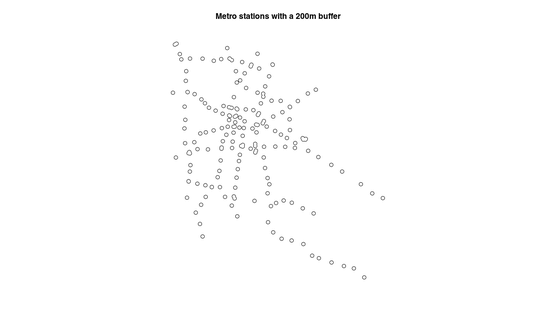
Note the merged stations. Now its just a matter of counting the number
of crimes inside each of the polygons taking into account the stations
that were merged.
| SELECT count(crime_lat_long.the_geom), stations.name AS name
FROM
(SELECT ST_Transform(ST_Union(the_geom),4326) as the_geom, name, sum(num)
from (SELECT ST_Buffer(the_geom_webmercator,200) as the_geom,name, line, num
from geocoded_stations) as buffers
GROUP BY name) as stations
LEFT JOIN crime_lat_long
ON st_contains(stations.the_geom, crime_lat_long.the_geom)
GROUP BY stations.name
|
Using carto:
1
2
3
4
5
6
7
8
9
10
11
12
13
14
15
16 | url <- str_c("https://diegovalle.carto.com/api/v2/sql?q=",
URLencode("SELECT count(crime_lat_long.the_geom), stations.name AS name
FROM
(SELECT ST_Transform(ST_Union(the_geom),4326) as the_geom, name, sum(num)
from (SELECT ST_Buffer(the_geom_webmercator,200) as the_geom,name, line, num
from geocoded_stations) as buffers
GROUP BY name) as stations LEFT JOIN
crime_lat_long
ON st_contains(stations.the_geom, crime_lat_long.the_geom)
GROUP BY stations.name"))
numcrime <-fromJSON(url)$rows
stations_merged@data <- left_join(stations_merged@data,
numcrime,
by = c("name" = "name"))
|
1
2
3
4
5
6
7
8
9
10
11
12
13
14
15
16
17
18
19
20
21
22
23
24
25
26
27
28
29
30
31 | stations_merged@data$rate <- stations_merged@data$count / stations_merged@data$sum * 10^5
# Exclude stations not inside CDMX (crime data only available in CDMX)
stations_merged <- stations_merged[!stations_merged@data$name %in% c("los reyes",
"la paz",
"nezahualcóyotl",
"impulsora",
"río de los remedios",
"múzquiz",
"tecnológico",
"olímpica",
"plaza aragón",
"ciudad azteca",
"cuatro caminos"), ]
# Write a geojson file for the interactive html version
writeOGR(stations_merged,
"html/stations.geojson",
driver = "GeoJSON",
layer = "stations.geojson",
verbose = FALSE)
map <- fortify(stations_merged, region = "name")
map <- left_join(map, stations_merged@data,by = c("id" = "name"))
bb <- bbox(stations_merged)
ggmap(get_map(location = bb)) +
geom_polygon(data= subset(map, rate != 0),
aes(long, lat, group = group, fill = rate)) +
scale_fill_continuous(low = "#ffeda0", high = "#f03b20") +
ggtitle(title) +
theme_nothing(legend = TRUE) +
ggtitle("Crime by Mexico City Metro Station")
|
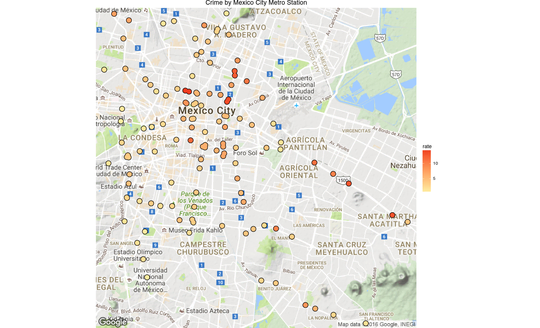
And there you have it, a chart with the crime rates by metro
station. There’s still a problem in that the crimes may be
systematically biased since the reporting rate is so low in Mexico
(93% according to the ENVIPE 2016).
You can also view an interactive version here
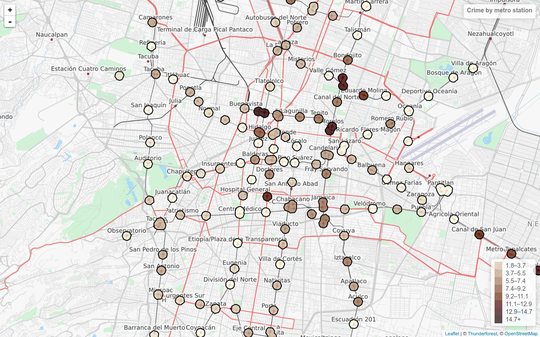
P.S. You can download the code from GitHub



























